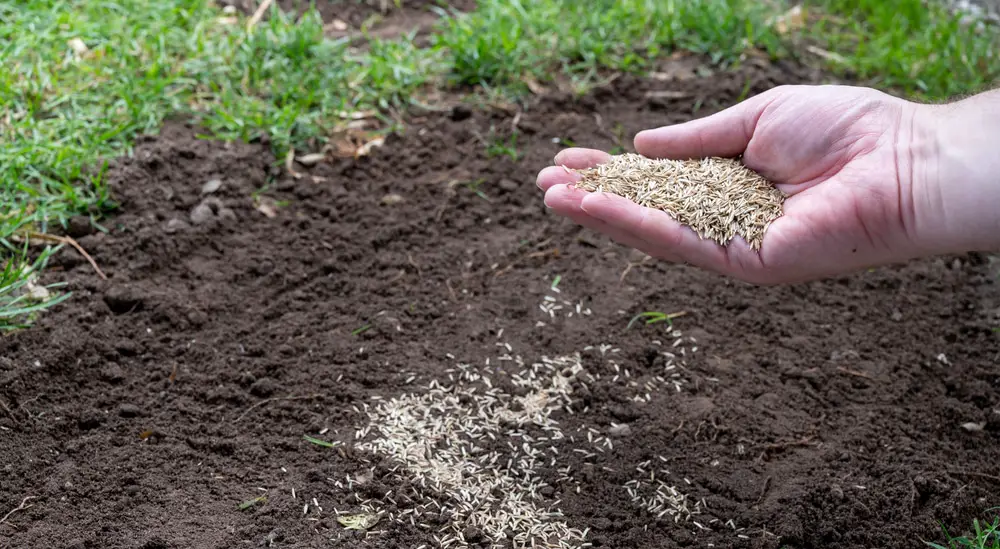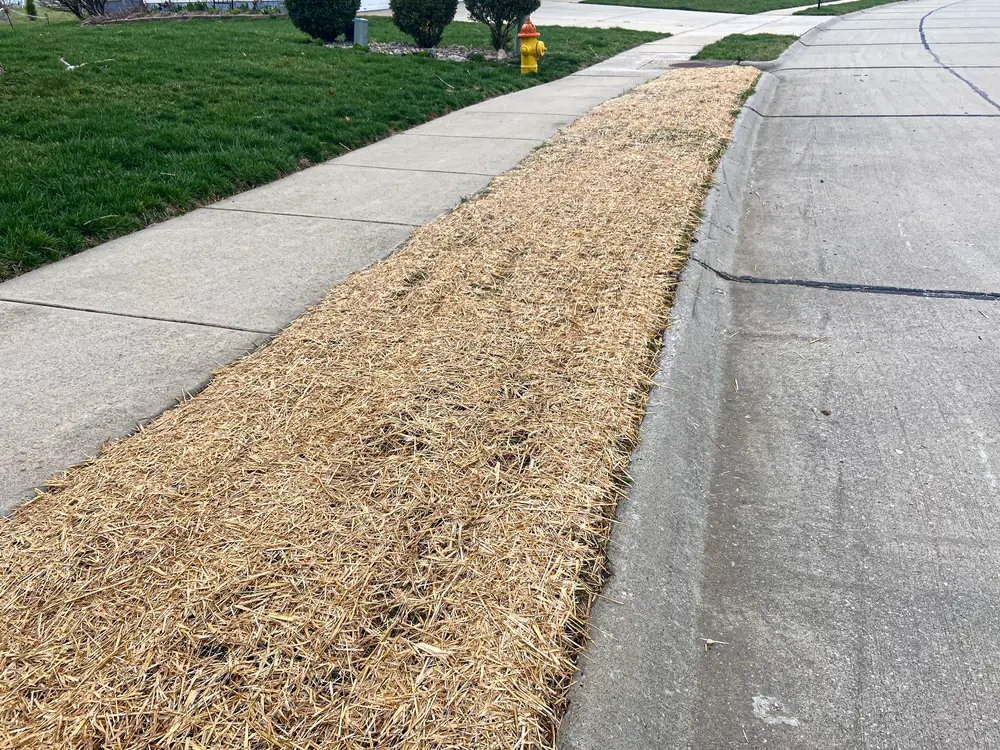What is the very best thing to cover a newly seeded lawn? Growing a green lawn is a labor of love and it takes time. It’s worth the effort and is something to treasure and enjoy.
Foremost, we understand that a thorough initial watering is the most important thing. It ensures that you keep the seed in place until it can germinate and develop its own root system in your lawn.
This article will give you more information about this cover grass seed option on newly seeded lawns. How to apply it, and more. Keep on reading, and here’s a closer look at what you need to know about using straw for lawn grass seed germination.

Why Placing a Straw to Cover Grass Seeds?
Of course, quality seed, moisture, and sunlight play a vital role in germination, however, if the seed may not be in contact with the soil so as to germinate, the process might not go well. The grass seed must touch the soil, a process helped along by heat and moisture.
That is where covering grass seeds with straw can help.
One of our main goals when planting a new lawn is to keep the grass seed in place until it germinates. This establishes a root system to anchor it to the soil.
The other one is to keep the newly planted seed sufficiently moist and warm to encourage germination.
These goals can be achieved by placing a thin layer of straw over the grass.
Hence, leaving it in place until the grass seedlings slowly appear.
Let us start with some of the benefits of placing straw over new grass seeds.
To prevent seed movement. It keeps the grass seed in place until germination from blowing around on windy days or washing away during heavy rainstorms. It encourages better growth and prevents any patchy areas in your new lawn.
It keeps the moisture. By placing a straw over new grass seeds helps to keep the moisture. It does not need water as much as possible to encourage grass seed germination.
It lessens direct sunlight exposure. The grass seeds may experience and might be exposed to too much direct sunlight if without a straw.
It discourages birds and small mammals from feasting on the grass seed. These small animals might see the grass seeds as their meal. The straw could be of help to protect new grass seedlings from these creatures.
Easy to apply and clean up. Most of the straws don’t even need to be removed after grass seed germination. It will simply decompose into the soil, as it decomposes, the straw contributes valuable nutrients to the soil.
Application – 7 Steps on How to Apply Straw Cover for Grass Seed?
1. To remove the debris and weeds. Clean and pick up some trash, plastic, rocks, or other debris from your lawn site. Pull some weeds so that they may not compete with the grass seed.
2. Prepare the soil and add organic matter. A start-up fertilizer could also be helpful with nitrogen, phosphorus, and potassium in it. Phosphorus is the most important nutrient for grass seed growth and so has the highest percentage.
3. Water thoroughly the lawn before planting. One week before you plant the grass seed, you must thoroughly water the lawn.
4. Sow the Grass Seed. To sow the first batch of grass seed, walk a north-south back-and-forth pattern to cover the area. Then, refill the spreader and walk an east-west pattern for the second batch of seeds. By walking through in both directions, you could distribute the seed evenly.
5. Cover the Grass Seed. Here are the steps to follow:
- To the side of the newly sown grass seed, lay down a tarp. You now place the bale of straw, which could be used as an alternative to grass seed mulch. Break it up on top with a pitchfork.
- Get a handful at a time. Then, loosen and shake it over the grass seed to blanket the area. You need the straw to barely cover the ground 1/4 inch deep.
- It should not be applied too thickly. It may defeat its own purpose and prevent the grass seed from growing.
- A bale of straw would cover roughly 1,000 square feet of lawn.
- You need not remove the straw. The grass will grow through it and it will naturally decompose in time.
- The straw must be applied before the initial watering in order to avoid walking on wet newly seeded soil.
6. Water it after the straw has been placed.
7. It is best not to press grass seed too deeply into the soil.
After How Long Should You Remove a Straw Blanket from the New Grass?
You cannot leave some of the straw blankets on the grass forever.
Somehow, it will decompose and rot naturally, it is a process.
Straw covers are great for seeding grass because they prevent solids from penetrating the soil.
It allows the water and oxygen to flow freely. Though promoting a healthy patch of grass. But, still, you cannot leave them forever.
You should remove a straw cover from new grass after four to five weeks or until the grass is long enough to move. Otherwise, you could cause damage.
It should be two to three inches tall.
Removing the straw cover too soon can rip out the roots, causing you to have to restart the process. Now, you can mow the grass one to two times.
Then detach or use a rake to remove the excess straw mulch. The remaining straw naturally decomposes into the soil.
You should look out for a few signs, such as the grass not growing through the straw cover on time. Thus, not showing signs of growth.
You may have to lift a portion of the straw cover to see if everything is working under the soil.
If you are ready to remove the straw cover from the new grass, head to the process below.
How to Remove Straw Cover from New Grass?
Just follow these steps to remove the straw cover from the new grass:
Let the grass grow to about three inches tall and long enough to move. The first few weeks after placing the straw cover on your grass are the most crucial and beneficial. Once the grass is long enough, there is no need for the straw cover to do anything other than decomposing naturally.
Mow the grass. Remove the top layer of grass and straw. You must follow some specific guidelines in case you are on the wall. To prevent the blades from chipping it. This brings the grass down to 2 to 2.5 inches.
Dethatch the lawn with a rake. You can also use a powered dethatcher. This would help remove the excess straw without ripping the grass from its roots.
Water the grass and regularly mowed. Although you’ve finished the hard part, you still have to water and maintain the grass. Just add a bit of fertilizer if you notice patches or lines.
Mow it regularly to keep the grass around 2.5 inches. This will prevent fungi, mildew, and bacteria from growing.
Remove the excess patches of straw cover if it doesn’t come out after a couple of months. The straw cover would not be gone after one mowing. So, you must maintain a consistent schedule every week or two until it is all gone.
When you notice a few chunks, after 60 to 90 days, remove them by hand.
These simple steps would ensure your grass gets the most out of the straw cover without smothering it.
It could be a great help to take away the stress off of your shoulders when it comes to moving, dethatching, and spending too much time removing the straw.
Why Does Straw Cover Need to Be Removed?
The straw seed cover needs to be removed if you added too much straw or if the grass seeds are not growing.
Check to see if you used the wrong type of straw cover for the lawn. Some confuse straw seed covers with erosion nets. The nets would not break down for a long time, while straw seed covers decompose quickly.
Here are a few reasons straw covers sometimes need to be removed from new grass:
The straw cover is too thick for the grass. The straw and dry grass can pile over the soil and make it difficult for the grass to grow to get enough of the nutrients it needs.
The grass will grow long enough whereas the straw cover is not breaking down as predicted. This will usually happen when using old, dry straw covers that won’t decompose.
It’s rather uncommon when the straw has been on the grass for too long after mowing a couple of times.
The underlying soil is not enriched or it’s too dry. You must add mulch, topsoil, or fertilizer to keep it moist.
Final Thoughts on Straw Cover for Grass Seed
A straw cover could be very effective. However, it’s important to dethatch the lawn after a couple of mowing sessions to free the growing grass.
You can remove the straw with gloves or shovels, or you can use your mower and a rake to gradually take it away.
Spread the love – Happy Gardening!
Read More:
12 Tips to Get Rid of Grub Worms on your Lawn 
Putting Salt on Grass (What you Need to Know!)
How Many Square Feet are on a Pallet of Sod? +Sod Calculator

